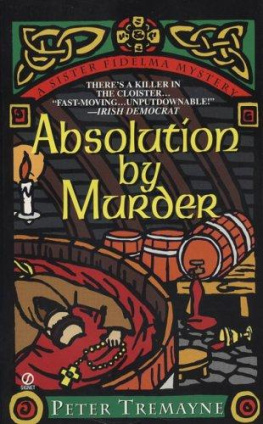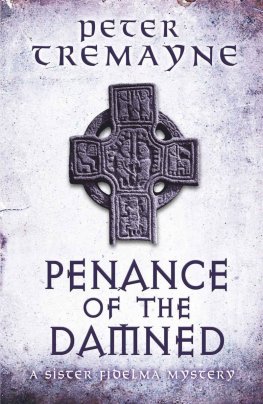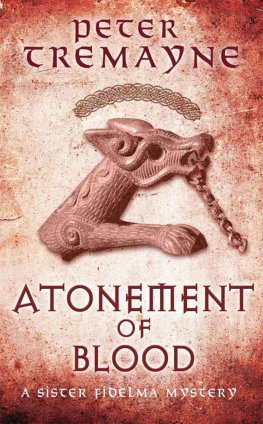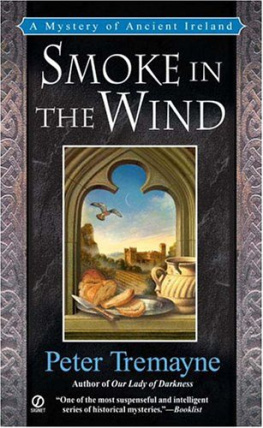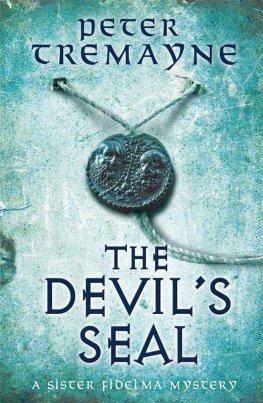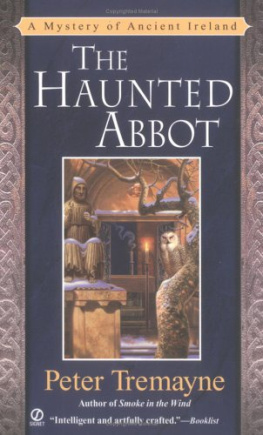Peter Tremayne - Hemlock at Vespers
Here you can read online Peter Tremayne - Hemlock at Vespers full text of the book (entire story) in english for free. Download pdf and epub, get meaning, cover and reviews about this ebook. genre: Detective and thriller. Description of the work, (preface) as well as reviews are available. Best literature library LitArk.com created for fans of good reading and offers a wide selection of genres:
Romance novel
Science fiction
Adventure
Detective
Science
History
Home and family
Prose
Art
Politics
Computer
Non-fiction
Religion
Business
Children
Humor
Choose a favorite category and find really read worthwhile books. Enjoy immersion in the world of imagination, feel the emotions of the characters or learn something new for yourself, make an fascinating discovery.

- Book:Hemlock at Vespers
- Author:
- Genre:
- Rating:5 / 5
- Favourites:Add to favourites
- Your mark:
- 100
- 1
- 2
- 3
- 4
- 5
Hemlock at Vespers: summary, description and annotation
We offer to read an annotation, description, summary or preface (depends on what the author of the book "Hemlock at Vespers" wrote himself). If you haven't found the necessary information about the book — write in the comments, we will try to find it.
Hemlock at Vespers — read online for free the complete book (whole text) full work
Below is the text of the book, divided by pages. System saving the place of the last page read, allows you to conveniently read the book "Hemlock at Vespers" online for free, without having to search again every time where you left off. Put a bookmark, and you can go to the page where you finished reading at any time.
Font size:
Interval:
Bookmark:
Peter Tremayne
Hemlock at Vespers
INTRODUCTION
The Sister Fidelma mysteries are set during the mid-seventh century A.D. mainly in her native Ireland.
Sister Fidelma is not simply a religieuse, a member of what we now call the Celtic Church whose conflict with Rome on matters of theology and social governance are well known. Apart from differences in rituals, the dating of Easter and the wearing of a dissimilar tonsure, celibacy was not widely practiced and many religious houses contained both sexes who raised their children to the continued service of God. Fidelma is also a qualified d-laigh, or advocate of the law courts of Ireland, using the ancient Brehon Law system. In those days, in Ireland, a woman could be coequal with men in the professions and many women were lawyers and judges. There is even a record that a female judge, Brig, corrected, on appeal, a judgment given by a male judge, Sencha, on womens rights.
Those who have followed Sister Fidelmas adventures in the series of novels might be unaware that she made her debut in short story form. Four different stories featuring Fidelma appeared in separate publications in October 1993. The gratifying response to those stories precipitated Fidelma into the series of novels but also created a demand for even more short stories. The fifteen stories in this volume comprise the complete set of those published at the time of this writing.
To let you into a secret, there might not have been a Fidelma. Under my other hat, as a Celtic scholar, I decided to create the concept of an Irish female religieuse who was a lawyer and solved crimes under the ancient Brehon law system of Ireland, primarily to demonstrate to a wider audience both the fascinating law system and the prominent role that women could and did play in that period. I drafted the first story back in 1993 and named her Sister Buan. It is an ancient Irish name which means enduring. Buan occurs in myth as a tutor to the hero Cchulainn. When I showed the draft story to my good friend Peter Haining, the anthologist and writer, he loved the story but threw up his hands in dismay at the name. He felt the name did not trip easily to the tongue in spite of its shortness.
As I reflected on this, suddenly, Fidelma was born. It was as if she had been waiting to catch my attention. The name is also ancient and means of the smooth hair. Once Fidelma introduced herself to me, everything fell into place. The name gave her an instant background and a family! The masculine and feminine forms of the name were popular among the royal dynasty of the Eghanachta who ruled the kingdom of Munster from their capital of Cashel (County Tipperary). And it was an area that I knew very well for my fathers family had been settled sixty kilometers from Cashel for seven hundred years, so the records show. Cashel was always a special place-of magic, mystery, and history, for me. Fidelma immediately identified herself as the daughter of the Cashel King Failbe Fland who died circa AD. 637/ 639 within months of Fidelma being born. So before she became a religieuse and a lawyer, Fidelma was raised as an Eghanachta princess.
Sharp-eyed readers will have realized that there is a strict chronology followed in the books. The stories have so far taken place between the spring of A.D. 664 and autumn of A.D. 666. In fact, A.D. 666 was a rather busy year for Fidelma as it was the setting for four book-length mystery adventures occurring between January and October.
That adherence to a set chronology also applies to the short stories. Fidelma appears in the first stories around the age of twenty-seven having trained not only at an Irish ecclesiastic center but having studied at the secular college of the Brehon (Judge) Morann at Tara. (There was a real Brehon Morann whose dictums still survive in ancient Irish literature.) Fidelma achieved her qualifications in law to the level of anruth, one degree below the highest that the ecclesiastical and secular colleges could bestow. While she was a student, she had an unhappy affaire de coeur with a warrior who was not her intellectual equal. She then joined the community which had been founded by St. Brigid at Kildare. While here, she started to achieve a reputation by solving difficult legal mysteries and her talents as a lawyer, a dlaigh in Old Irish, became much in demand.
Readers may be surprised that Brother Eadulf plays no part in any of the short stories. In the first novel, Absolution By Murder, Fidelma, already with a reputation as an incisive inquirer and legal expert, was sent to advise the Irish delegation at the Synod of Whitby in A.D. 664. This Synod was the location of the famous historical debate between representatives of the Celtic and the Roman Church. It was there that Fidelma met the young Saxon monk named Brother Eadulf. He had been trained in Ireland but now wore the tonsure of Rome. He became her Doctor Watson and has featured in every novel except one-Suffer Little Children.
In the following stories, Fidelma herself solves the mysteries without Eadulfs good intentioned but often critical assistance. This is partially because several of the stories are set prior to Fidelmas meeting with Eadulf. Stories such as Murder in Repose and Murder by Miracle are two of Fidelmas early cases. Other early adventures are Tarnished Halo, Abbey Sinister, and Our Lady of Death. For the very sharp-eyed, a chronological pattern can also be followed in these stories. Yet each story is complete and does not necessarily have to be read in a chronological method.
In the early stories, Fidelma announces herself as Fidelma of Kildare. A reader once wrote and asked me why she decided to leave that community. (After the events of Suffer Little Children she takes on the mantle of Fidelma of Cashel.) The reason why she began her break with Kildare is explained in Hemlock at Vespers. At that point, Fidelma set off to discuss her problems with her mentor, the chubby-faced and kindly Abbot Laisran of the great abbey of Durrow where, in the mid-seventh century, young men and women from no less than eighteen nations are recorded as students. A Canticle for Wulfstan is located at Durrow. While there, Fidelma receives a cry for help from a close friend of her childhood, a girl she has grown up with, who has been accused of murdering her husband and her own child. The resultant adventure is told in At the Tent of Holofernes. On her continued journey to the High Kings court at Tara, she finds that the Yellow Plague, which devastated much of Europe at this time, had been instrumental in causing the death of the joint High Kings, Diarmuid and Blathmac. The new High King, Sechnasach, is about to be installed but part of the ceremonial regalia has gone missing. Civil war and anarchy could result if Sechnasach cannot prove his right to the kingship by showing the sacred artifacts. The mystery is recounted in The High Kings Sword.
From there, Fidelma is off to Whitby to attend the Synod, as previously mentioned. From Whitby she travels to Rome with a party which includes Brother Eadulf. In the autumn of that year, the newly appointed Archbishop of Canterbury is found murdered in the papal palace-an actual historical event-and Fidelma and Eadulf join forces again to solve the mystery in Shroud for the Archbishop. The short story The Poisoned Chalice is also set in Rome in this same period but, again, Eadulf is not in attendance. Fidelma and Eadulf part company in Rome; Fidelma to return home while Eadulf is to instruct the new archbishop of Canterbury, Theodore of Tarsus, before accompanying him to England to assume his duties. Fidelma makes her journey home via the Abbey of Nivelles, an Irish foundation in the forest of Seneffe, in what is now Belgium, where Holy Blood takes place.
Back in Ireland in AD. 665 she returns to Tara, the setting for A Scream from the Sepulcher. She goes back to Kildare where she solves a race-course mystery in The Horse That Died for Shame. She is uncomfortable at Kildare and when her brother, Colg, sends her a message to return to Cashel because her help is urgently needed, she sets off eagerly.
Font size:
Interval:
Bookmark:
Similar books «Hemlock at Vespers»
Look at similar books to Hemlock at Vespers. We have selected literature similar in name and meaning in the hope of providing readers with more options to find new, interesting, not yet read works.
Discussion, reviews of the book Hemlock at Vespers and just readers' own opinions. Leave your comments, write what you think about the work, its meaning or the main characters. Specify what exactly you liked and what you didn't like, and why you think so.

